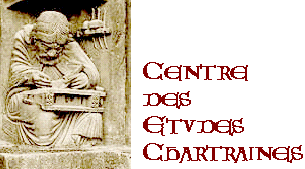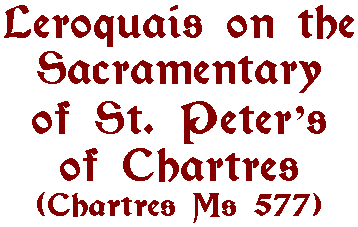|
Feuillet
de garde. D'une autre main (XIe s.) « Frotbaldus ep. Teodericus ep. Arnulfus
albas. Landricus albas. » II s'agit de Frotbold (+ 858) et de Thierry
(+ 1048) évêques de Chartres ; d'Arnulfe (+ 1033) et de Landry (+ 1069),
abbés de Saint-Père. Fol. 1 à 6. De différentes mains (XIe et XIIe s.).
— 1. (XIe s.) : « Contemplatio. In spiritu humilitatis et i. a. c. ante
sanctum altare tuum et sacratissimum corpus et sanguinem tuum, Domine
lesu Christe, redemptor mundi, accedimus... aecclesia tua haec, Domine,
quam priscis temporibus fundasti et sublimasti in honore et nomine sanctorum
apostolorum Petri et Pauli et omnium apostolorum, sedet in [p. 76] tristitia...
» Prière contre les spoliateurs de l'Eglise.
— 1v°. « Missa pro iter agentibus. — (1er sept.) « S. Egidii abb. »
— 2. « Missa in translatione sive commemoratione ss. Dyonisii, Rustici
et Eleutherii. »
— Fol. 2v°. « Dum miscetur corpus cum sanguine. Haec sacrosancta commixtio
corporis et sanguinis D, n. I. C... — Oratio ante communionem. Domine
sancte, Pater omnipotens, aeterne Deus, da mihi hoc corpus et sanguinem
F. t. D. n. I. C. ita sumere, ut merear per hoc remissionem omnium peccatomm
accipere, et tuo sancto Spiritu repleri. Qui vivis... » — 3. « Oratio
sacerdotis quando offer (sic) Deo oblatam. Suscipe, sancta Trinitas, hanc
oblationem quam tibi offero in memoriam incarnationis, nativitatis, passionis,
resurrectionis ascencionisque D. n. I. C... »
— Fol. 3. « Oratio pro semetipso quando levatur oblata. Suscipe, clementissime
Pater, hanc oblationem quam tibi offero ego indignus famulus tuus... »
— 3. « Or. post com. Domine Iesu Christe, Fili Dei vivi, qui ex voluntate
Patris...» — «Post missam dicat sacerdos ante altare. Placeat tibi, Domine
Deus, sancta Trinitas, obsequium servitutis meae...» — Toutes ces prières
sont en écriture du XIe s.
— 3v°. (XIIe s.) : « Missa communis. »
— 4v°. (XIe s.) : [In nat. sancte Praxedis virg.] — « In nat. sancte Petronille
virg. »
— 5. « Missa in inventione s. Stephani. »
—5v°. (XIe s.) (6 déc.). « Nat. s. Nicholai ep. et conf. »
— Fol. 6. « In nomine Domini. Incipit liber sacramentorum de circule anni
expositus, a sancto Gregorio papa romano editus, ex autentico libro bibliothecae
cubili scriptus, qualiter missa romana celebratur... »
— Fol. 8. Canon. Aucun Amen. — Mêmes signes de croix qu'aujourd'hui, sauf
ceux du Supplices (celui de « sanguinem » a été ajouté, celui de «benedictione»
manque) et de Per ipsum (ceux de « cum ipso » et de « in ipso » font défaut).
— 8v°. « Te igitur.. una cum famulo tuo papa nostro ill. et antistite
nostro ill. et rege nostro ill. (ce qui suit est d'une autre main : «
et omnibus... cultoribus. ») — Mémento, Domine, f. f. t. N. (souvent trois
lignes effacées) et omnium... cognita est et nota devotio (suit une demi-ligne
grattée et effacée) qui tibi offerunt hoc sacrificium... »
— Fol. 10v°. « Mémento mei peccatoris, quaeso, Domine, et licet haec sancta
indigne, tibi, sancte Pater, omnipotens, eterne Deus, meis manibus indignis
offerantur sacrificia, qui nec invocare sanctum ac venerabile nomen tuum
dignus sum, sed quoniam in honore, laude et memoria glorisissimi dilecti
F. t. D. n. I. C. offeruntur, sicut incensum in conspectu divine maiestatis
tuae cum odore suavitatis acceptentur. Per. » — « Mémento etiam, Domine,
...» — 11v°. « Pax D. s. s. v. Et c. s. t. — Agnus Dei... Tribus vicibus.
»
— Fol. 11v°. « VIIII kal. ian. Vig. D. n. I. C.... » Nombreuses préfaces
; elles figurent entre la secrète et la postcommunion ; on en compte 220
de première main ; elles diffèrent notablement de celles de l'Ottobonien
quant à l'ordre et au texte.
— 17v°. « Kal. ian. Nat. sanctae Mariae. » — 18. « Missa in octabas Domini.
»
— 19. « Dom. I post oct. Domini. » — « Vig. Teophaniae. »
— 21. « Missa in octabas Epiphania (sic). »
— 21v°. « Dom. I post Teophania. »
— 24. « Dom. VI post Teophania. »
[p. 77]
— Fol. 24. « Dom. in Septuagesima. »
— 27. « Sabbatrm [post cineres]. »
— 53v° « Sequitur ordo qualiter sabbato sancto Pasche, secundum Gregorium
papam, in ecclesia agi debeat. In primis induunt se omnes albis et pergant
propter ignem novum ad portam monasterii... »
— 54v°. Exultet noté ; notation neumatique : école française.
— 55 v°. L'éloge de l'abeille a été gratté et effacé.
— 56. « Precamur ergo te... una cum famulo (au-dessus de la ligne et d'une
autre main : beatissimo) tuo papa nostro (suit une ligne et demie grattée
et effacée ; le texte primitif a été remplacé par : « et rege nostro et
antistite nostro.») — Dans les marges de ce feuillet et du suivant figure
cette indication en regard des oraisons : « G G » (Gregorius).
— Fol. 58. « Dominica sancte resurrectionis. »
— 61v°. « Dom. post albas. »
— 62 « In pascha annotenum (sic). »
— 66. « In vig. Ascensionis. »
— 69v°. « In die sancto Pentecostes. »
— 71v°. « Feria V [post Pent.]. »
— 73v°. « In oct. Pent. De sancta Trinitate. »
— 74v°. « Dom. I post oct. Pent. »
— 88 « Dom. XXVII post oct. Pent. Hec dom. V ante natale Domini. »
— 92. « Dom. [I] ante natale Domini. »
— 94 à no. D'une autre main (XIIe s.). Messes votives et messes diverses.
— 94. « Missa de sancta Trinitate. »
— 95. « Missa in honore petri et pauli. » — « Missa in honore beati Benedicti.
»
— 98. « Missa pro congregatione loci. »
— 102v°. « Missa pro comitissa Legardi[1] et pro aliis familiaribus nostris. »
— 106. « Missa pro populo ad crucifixum. »
Fol.
110 à 170. Sanctoral.
« Nat. s. Silvestri papae. » — Ci-après la série des messes qui ne figurent
pas dans le sanctoral grégorien.
— 110v°. « Nat. s. Mauri monachi. »
— 111v°. « Nat. s. Sulpicii ep. et conf. »
— 112. « Nat. ss. mart. Marii et Marthe. »
— 114. « SS. Emerentiane et Macharii et Parmenii diac. — Nat. s. Preiecti
mart. » En marge et d'une autre main : « et Saviniani. »
— 114v°. « Conversio s. Pauli.
— 117. « Nat. sancte Scolastice virg. »
— 117v°. « Sancte Sotheris virg. — SS. Zotici et Hyrenei et lacincti.
»
— 118. « Nat. ss. mart Vitalis, Felicule et Zenonis. »
— 118v°. « Nat. sancte Iuliane virg. »
— 119. « Cathedra s. Petri apost. »
— 119v°. « Nat. s. Mathie apost. »
— Fol. 120. « Nat. s. Albini ep. et conf. »
— 120v°. « Perpetue et Felicitatis. »
— 121. « Vig. s. Benedicti abb. »
— 121v°. « Nat. s. Benedicti abb. »
— 123. « Nat. s. Leonis pape. »
— 123v°. « Nat. sancte Eufemie virg. »
— 124v°. « S. Marci evang. »
— 126. « S. luvenalis. »
— 126 v°. « Inventio sancte crucis. » — La fête du 6 mai est ainsi désignée
: «Regressio s. lohannis evangeliste de exilio.»
— 128. « SS. Nerei et Achillei. »
— 128. La fête du 13 mai est désignée sous ce titre : « Dedicatio basilice
sancte Marie. » Les oraisons sont celles du sacramentaire grégorien.
— Fol. 129v°. « SS. Primi et Feliciani mart. »
— 130. « Basilidis, Cirini, Naboris et Nazarii mart. — S. Viti mart. »
— 130v°. « Cirici et lulitte matris eius. »
— 131v°. « Vig. ss. mart. Gervasii et Protasii. »
— 133v°. « Vig. ss. lohannis et Pauli. »
— 136v°. « Transi, s. Benedicti abb. »
— 137. « Sancte Marie Magdalene » (préface spéciale).
— 137v°. « S. Apollinaris. » — « Nat. s. Iacobi apost. »
— 139v°. « Nat. s. Germani ep. Autissiodorensis. »
[p. 78]
— Fol, 140v°. « SS. Machabeorum. »
— 141. « Inventio corporis s. Stephani et alior. »
— 142v°. « Nat. s. Donati ep. et mart. »
— 146. « Oct. s. Laurentii. »
— 147. « S. Magni mart. »
— 148. « Nat. s. Simphoriani mart. » — « S. Bartholomei apost. »
— 148v°. « Nat. s. Rufi mart. » — « Nat. s. Augustini ep. »
— 150. « Decollatio s. Ioh. Bapt. » — 150. « Nat. s. Prisci mart. »
— 151. « S. Adriani mart. »
— 152. « Nat. s. Gorgonii mart. »
— 154v°. « Vig. s. Mathei apost. »
— 155. « Natalis. » — « S. Mauricii c. s. s. »
— 156v°. « Nat. s. Hieronimi presb. »
— Fol. 157. « SS. Germani et Remigii. »
— 157v°. « Nat. s.. Leodegarii ep. et mart. »
— 158. « SS. Marcelli et Apulei, Sergii et Bacchi. »
— « Vig. s. Dionisii ac soc. eius. »
— 158v°. « In die. »
— 159v°. « S. Luce ev. »
— 160. « Vig. apost. Symonis et Iude. » —160. « In die. » — « Vig. omnium
sanctorum. » — 161. « Missa in die omnium sanctorum. »
— 162v°. « Vig. s. Martini. »
— 164. « Missa quotidiana de s. Martino conf. » — « In oct. s. Martini.
»
— 164v°. « Vig. sancte Cecilie virg. »
— 166v°. « SS. ...Chrisanti, Mauri et Darie. »
— 168. « In oct. s. Andreae. »
— 168v°. « Nat. s. Damasi papae. »
— 169. « Nat. s. Thome ap. »
Fol.
169v° à 173v°. Commun des saints.
— 173v°. « In ecclesia cuiuslibet mart. vel conf. sive virg. » Dans les
oraisons de la messe, une main contemporaine du manucrit a ajouté le nom
de sainte Soline dont le corps était conservé dans l'église abbatiale.
— 175v° à 190v°. Messes votives et messes diverses.
— 175v°. « Missa de sancta Trinitate. »
— 176. «Missa ad suffragia angelorum postulanda.» — «Missa in honore sancte
crucis.» — 176v°. « Missa in veneratione sancte Marie sabbato. »
— 177. « Missa cotidiana ad poscenda suffragia omnium sanctorum. »
— 177v°. « Missa pro congregatione monachorum. »
Fol.
189. « Missa pro congregatione. Familiam huius sacri caenobii, quesumus,
Domine, intercedentibus omnibus sanctis tuis (en marge et d'une autre
main : « intercedente beato Petro apostolo tuo cum) ... »
— 190 à 202v°. Bénédictions épiscopales. Elles sont au nombre de 53 et
présentent, au point de vue de l'ordre et du texte, des divergences avec
celles de l'Ottobonianus.
— 201v°. « Benedictio in dedicatione ecclesie. Omnipotens Deus, qui hoc
templum sanctum suo glorisissimo nomini, in honorem beatorum apostolorum
petri et pauli voluit dedicari... »
— 202v° à 205. Epîtres et évangiles de quelques messes votives.
Parch.,
205 ff. à longues lignes. — 285 sur 215 mill. — Peinture à pleine page
d'exécution barbare : fol. 6v°, crucifixion. — Grandes initiales à entrelacs
terminées par des têtes d'animaux : fol. 7, V et fol. 8, T. — Initiales
vermillon et noir alternativement. Rel. peau blanche sur bois ; traces
de fermoirs (Saint-Père). — delisle, Sacramentaires, p. 181 à 183 ; notice
LIII.
[1] Letgardis, wife of Count Theobald I (“le Tricheur”),
mentioned in charters from St. Peters (CSP pp. 63-5, 79) and possessed
property at Illiers-l’Évêque, Juziers (given to St. Peter’s, Obits 197F),
Fontenay-Saint-Père, Arnouville, Mantes-la-Ville, Limay, Issou and Frémainville,
the latter five given to St. Mary’s of Mantes (Obits 376B). She may have
inherited some of this property from her father, Count Herbert II of Vermandois
(though Longnon doubts this supposition of d’Arbois de Jubainville, Hist.
ducs et comtes de Champagne, I, p. 136). She is mentioned briefly in the
oldest surviving necrology of he cathdral (Obits 18B, 23F); and that of
St. Mary’s of Mantes her gifts of property are ennumerated (Obits 376B,
12 November). And in that of St. Peter’s as the mother of Archbishop Hugo
of Bourges (Obits 179A) ; and on her own (Obits 197F : “[14 Nov.] Obiit
in Christo domna Legarda, Carnotensium nobilis comitissa bone memorie,
que dedit Sancto Petro ultra Sequanam Gisecium et Fontenidium.)” She was
still alive in 978, and perhaps until 985 (CSP p. 79), dying on a 14 or
12 November (Cf. Longnon’s preface in Obits, pp. iv-v).
The question arrises, how is it that there is --if Leroquais'
dating of the paleography can be trusted-- a 12th century interpolation
into the calendar of this otherwise 11th century manuscript (or, if we
can credit the dating given at the beginning of his entry ("Xe Siècle,
2e Moitié") which records a mass for a Countess/patroness
of the abbey who died between 978 and 985. Such an interpolation
could be understood, in theory, if the major part of the manuscript were
completed before 985 and the Countess' death (and, presumably, the disposition
of her will) required the insertion of a new commemorative mass into the
existing schedule of abbey's opus dei.
But why would such an entry for a person who died over a century
before be added in the 12th century into a calendar which
largely dated from the eleventh century?
[2] [3] [4]
|


![]()
![]()


